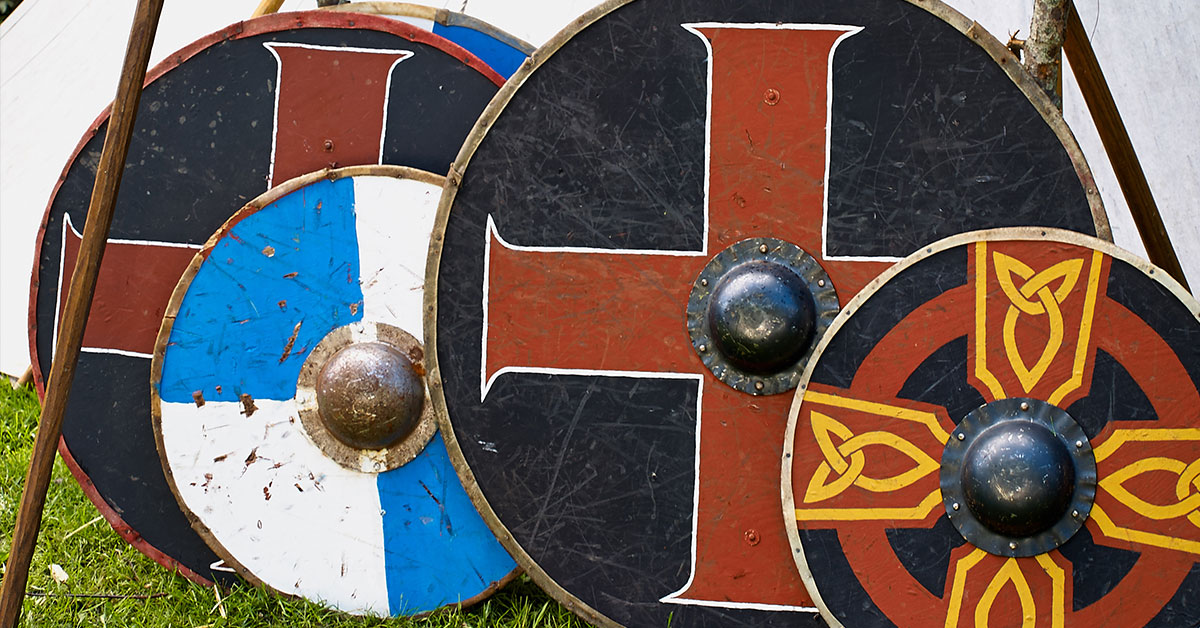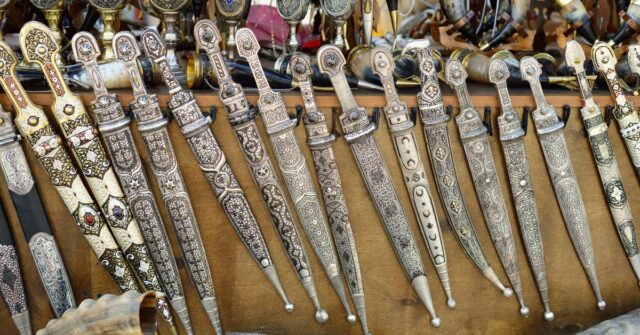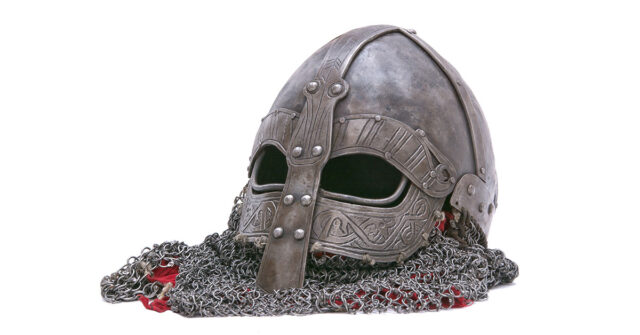In this article, we will explore the fascinating world of Viking shields, delving into their materials, construction methods, and the defensive strategies employed by the fierce Norse warriors.
Viking shields played a crucial role in their warfare and raids, and understanding their design and use can offer insights into the lives and culture of the Vikings.
Introduction to Viking Shields
Viking shields were an essential piece of equipment for the Norse warriors during the Viking Age (circa 793–1066 AD). These shields not only provide protection in battle but also symbolized their prowess and strength.
The Viking shield is an iconic representation of their warrior culture, and this article aims to provide a comprehensive understanding of its various aspects.
Materials Used in Viking Shields
Wood
The primary material used for constructing Viking shields was wood, typically lime, alder, or poplar. These types of wood were chosen for their lightweight and durable properties, making them ideal for shield construction.
The wooden planks were carefully selected and cut to create a strong, flexible, and resilient shield.
Rawhide
Rawhide, made from the skin of animals, was used to cover the wooden shield’s surface. The rawhide provided additional strength and protection, as well as a smooth surface for painting and decoration.
The rawhide was soaked in water and then stretched over the shield, shrinking as it dried and creating a tight, protective covering.
Iron and Metal Fittings
Iron was used for the shield’s central boss, which covered the warrior’s hand and provided additional protection from enemy blows. The boss was typically conical or hemispherical in shape and riveted to the shield.
Additionally, some shields featured metal reinforcements on the edges, further strengthening the shield’s structure.
Leather
Leather was sometimes used as an alternative to rawhide for covering the shield’s surface. Leather provided similar benefits in terms of durability and protection but was often considered more valuable and harder to acquire.
Some shields also featured leather straps for carrying or securing the shield during battle.
Construction of Viking Shields
Shape and Size
Viking shields were predominantly round, with a diameter typically ranging from 80 to 100 centimeters (31 to 39 inches). The round shape allowed for maximum coverage and maneuverability during combat.
The size of the shield varied based on the individual warrior’s preferences and stature.
Wooden Planks
The wooden planks used for constructing the shield were generally thin, ranging from 6 to 10 millimeters (0.24 to 0.39 inches) in thickness.
The planks were arranged radially, with their edges touching or slightly overlapping. They were then glued or nailed together, forming a sturdy base for the shield.
Iron Boss
The iron boss was an essential component of the Viking shield, providing a protective covering for the warrior’s hand. The boss was attached to the shield’s center with rivets, securely fastening it to the wooden structure.
The boss also served as a weapon, allowing the warrior to strike with the shield in close combat situations.
Edging and Facing
Once the wooden base and iron boss were assembled, the shield’s edges were reinforced with rawhide or leather strips. The rawhide or leather was soaked and then wrapped around the edge of the shield, providing additional protection and durability.
The shield’s surface was then covered with a layer of rawhide or leather, which was tightly stretched over the wood and secured with glue or nails.
This facing helped protect the wooden structure from damage and provided a smooth surface for painting and decoration.
Shield Handles
Viking shields featured handles on the reverse side, allowing the warrior to firmly grip the shield during combat. The handle was usually made of wood or metal and was positioned directly behind the iron boss.
Some handles were fixed, while others were adjustable, allowing the warrior to change the angle of the shield for better coverage and maneuverability.
Paint and Decoration
Many Viking shields were painted and decorated, both for aesthetic reasons and to provide additional protection. The paint was applied to the rawhide or leather surface, often in bright colors and intricate patterns.
Some shields featured geometric designs, while others displayed images of animals, mythological creatures, or religious symbols. The paint not only added a personal touch to the shield but also helped to protect the rawhide or leather from moisture and wear.
Defensive Strategies and Techniques
Shield Wall Formation
One of the most effective defensive strategies employed by the Vikings was the shield wall formation. Warriors would stand side by side, with their shields overlapping, creating a formidable barrier against enemy attacks.
The shield wall allowed the Vikings to withstand incoming blows, maintain their position, and protect vulnerable archers or injured comrades in the rear ranks.
Individual Combat Techniques
Viking warriors were skilled in using their shields for both defense and offense during individual combat. The round shape and size of the shield allowed them to easily deflect or block enemy blows, while the iron boss provided a weapon for striking or pushing opponents.
Additionally, the warrior could use the shield’s edge to deliver powerful strikes or to hook and disarm an enemy’s weapon.
Parrying and Blocking
Effective parrying and blocking techniques were essential for Viking warriors, as their shields were often their primary means of defense.
By angling the shield and using its curvature to their advantage, the warriors could deflect incoming blows and minimize the force of impact. This required a great deal of skill, practice, and an understanding of the shield’s strengths and limitations.
Viking Shield Variations
Round Shields
As mentioned earlier, the most common type of Viking shield was the round shield. These shields provided excellent coverage and maneuverability, making them suitable for various combat situations.
Round shields were used by both infantry and cavalry and were favored for their versatility and effectiveness.
Kite Shields
Although less common, kite shields were also used by some Viking warriors. These shields were elongated and tapered, with a rounded top and a pointed bottom.
The design of the kite shield provided better leg protection and was particularly useful for mounted combat. However, their larger size and reduced maneuverability made them less popular among Viking infantry.
Significance of Viking Shields in Warfare
Role in Viking Raids
Viking shields played a crucial role in the success of their infamous raids. The lightweight and versatile design of the shield allowed the warriors to move quickly and efficiently, both on land and at sea.
During raids, the shield wall formation enabled the Vikings to maintain their position and launch coordinated attacks on their targets, overwhelming their opponents with their superior tactics and discipline.
Symbolism and Cultural Importance
Aside from their practical uses in warfare, Viking shields also held significant cultural importance. Shields were symbols of a warrior’s status, strength, and bravery.
They were often decorated with personal and meaningful designs, reflecting the warrior’s identity, beliefs, and allegiances.
Furthermore, shields played a role in various religious and ceremonial practices, such as being used as burial offerings or in ritualistic dances and processions.
Viking Shields in Archaeological Finds
Notable Shield Discoveries
Throughout the years, several notable Viking shield discoveries have been made at various archaeological sites. These finds have helped researchers gain a better understanding of shield construction, materials, and usage.
Some of the most significant shield discoveries include those found at the Gokstad ship burial in Norway, the Oseberg ship burial, and the Trelleborg fortresses in Denmark.
Preservation and Reconstruction
Due to the organic nature of their materials, many Viking shields have not survived the test of time. However, some shield remnants have been preserved in waterlogged or anoxic conditions, such as in ship burials or bog deposits.
These preserved fragments provide valuable information for researchers and allow for accurate reconstructions of Viking shields.
Modern replicas and experimental archaeology have also contributed to our understanding of Viking shield construction techniques and their performance in combat.
Conclusion
Viking shields were an essential aspect of Norse warfare, providing protection, tactical advantages, and a symbol of strength and status.
Their unique construction, materials, and design made them highly effective in various combat situations, contributing to the Vikings’ reputation as formidable warriors.
Through archaeological finds and modern research, we continue to learn more about these iconic shields and their significance in Viking culture and history.











